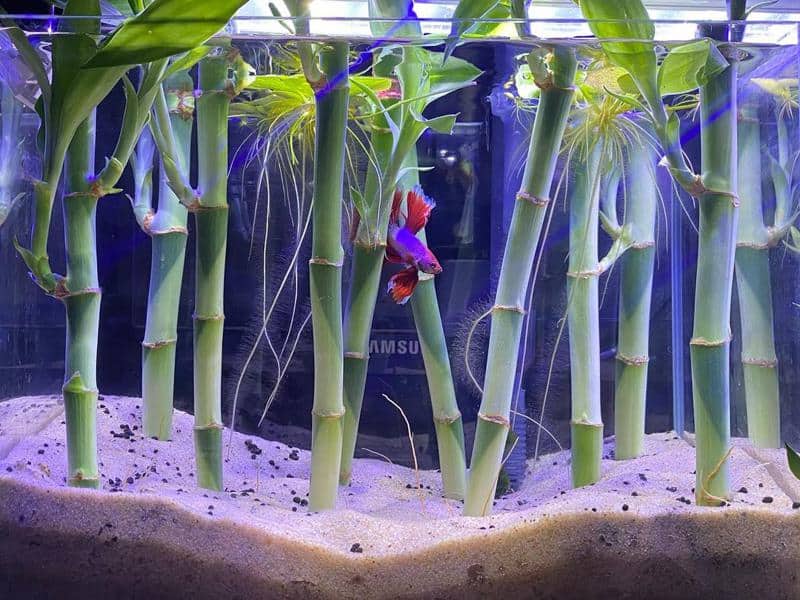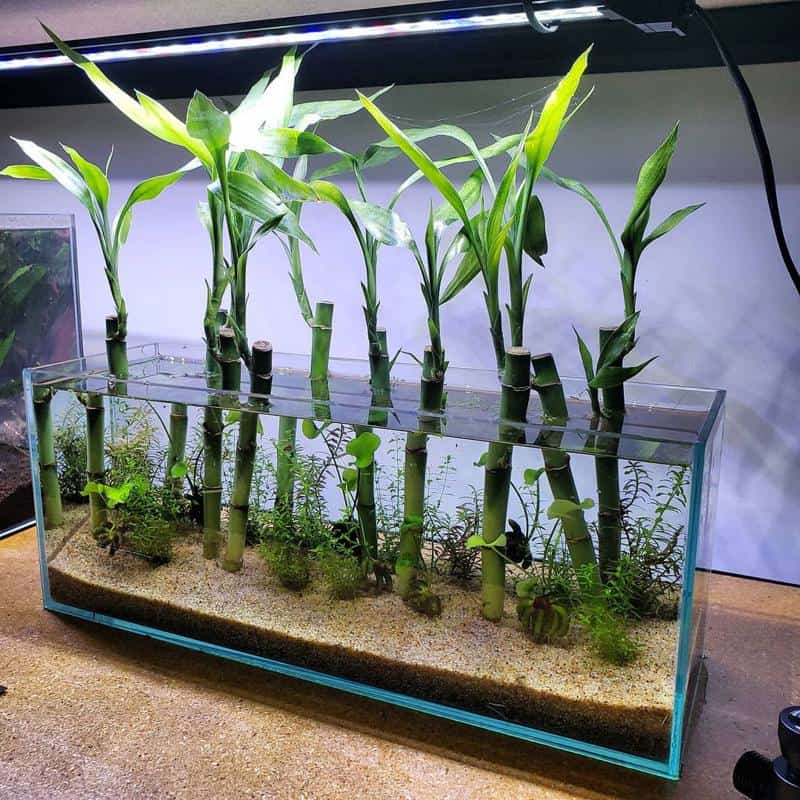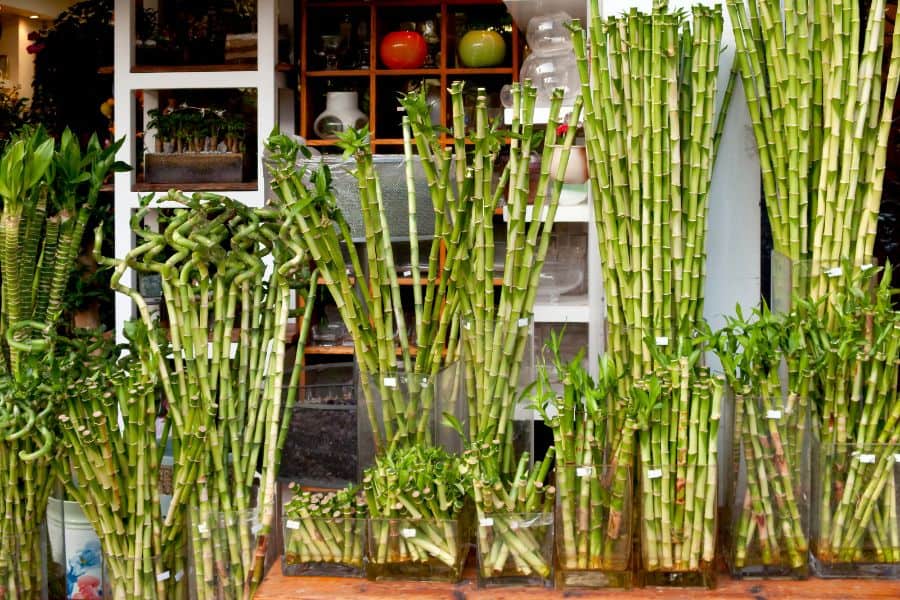Perhaps you’ve been thinking about adding bamboo to your fish tank, however, you’re not sure if they’re compatible and how to take care of it.
In this article, we’ll show you what kind of bamboo is most fitting for your fish tank, how to take care of it, any difficulties you may come across, and the benefits it can bring to your tank.
Regular bamboo cannot be placed in a fish tank; instead, you’ll have to use a type known as lucky bamboo, which can grow and thrive underwater.

Lucky bamboo has various benefits for your tank, including improving the overall aesthetics, pulling excess nitrates from the water, and increasing oxygen levels in the water.
Before continuing to discuss how you can grow lucky bamboo and troubleshoot any problems you may have, let’s first look at the types of bamboo there are and why you can only grow lucky bamboo, but not regular bamboo, in your aquarium.
Types of Bamboo
Here, we’ll take a detailed look at regular bamboo and lucky bamboo separately, before creating a table to compare and contrast the two.
What is Regular Bamboo?
When I say regular bamboo, I’m talking about the tall, thick bamboo that pandas enjoy chewing on. These are a group of perennial evergreens that are part of the true grass family Poaceae.
That’s right, regular bamboo is a type of grass, and is actually the largest member of the grass family. Secondary growth is absent in bamboo, palms, and other monocots, meaning they can only grow in a columnar, rather than tapering, fashion.
Bamboos are some of the fastest-growing plants in the world, capable of growing around 60 cm per day depending on the soil and climate conditions. Because of their size and strength, bamboo is often used as building materials, as a food source, and as raw products.
There are over 1,450 species of bamboo spread across the world, from frigid mountains to scorching tropical regions. More details on regular bamboo can be found here.
What is Lucky Bamboo?
If you’ve ever seen a small bamboo in a bowl with twisting stalks, its most likely you’ve seen a lucky bamboo. Lucky bamboo is a species of flowering plant in the family Asparagaceae.
Though this plant shares the bamboo name, it’s actually part of an entirely different taxonomic order from regular bamboo (note that both are monocots, however). This means that, although lucky bamboo and regular bamboo are barely related, they both grow in a similar, columnar fashion.
Though lucky bamboo may appear similar to regular bamboo at first glance, as you might’ve noticed, they are much smaller, with them only capable of reaching a height of 39 inches (100 cm) at most.
Unlike regular bamboo, lucky bamboo has a fleshy stem, hence they are not nearly as strong. Another difference is that, unlike regular bamboo, lucky bamboo can be grown in both soil and water-only environments, making them an ideal houseplant.
Comparing the Two Types of Bamboo
Here is a list compiling the similarities and differences between regular bamboo and lucky bamboo:
| Regular Bamboo | Lucky Bamboo | |
| Taxonomy | Poaceae family | Asparagaceae family |
| Appearance | Grow in clusters from a thick rhizome; grows up to 60 cm/day for a max. height of over 100 feet in some species | Highly resemble regular bamboo with light green shoots and slim, long leaves; grows up to 19 inches every 6 months for a max. height of 39 inches |
| Stem Structure | Hollow stem | Fleshy stem |
| Growth Substrate | Deep, well-drained soil | Well-drained soil, pebbles, water only |
| Plant Type | Monocot | Monocot |
How to Grow Lucky Bamboo?
Here are the materials and steps you’ll have to follow in order to grow your own lucky bamboo in your aquarium.
Materials You’ll Need
- A minimum 5-gallon fish tank
The 5-gallon fish tank is the minimum size required for lucky bamboo to grow and propagate. It’ll also guarantee that everything else placed on this list can fit in the tank.
It’s best, however, that you choose a tank of greater volume as the relatively strong water current can thrash the fish in the tank around.
- Liquid carbon dioxide/pressurized/canister CO2 system
- Bubbler/air stones
- Strong output filter
These items are used to provide the lucky bamboo with ample carbon dioxide, oxygen, and aeration.
However, keep in mind that these parameters are recommended for fully submerged lucky bamboo; they can be lowered if you have a partially submerged lucky bamboo plant.
- Nutrient-rich plant substrate
Although lucky bamboo can grow in just water, you’ll need plant substrate if you want to anchor it in your aquarium
- Indirect sunlight
- Freshwater only
Lucky bamboo cannot tolerate brackish or saltwater. Besides this requirement, lucky bamboo can tolerate a wide range of temperatures, pH, and other water conditions.
- Thermometer
Needed to measure the water temperature
- Scissors
Needed for plant propagation
Steps to Follow
- Once you have the lucky bamboo, make sure to plant it in a nutrient-rich substrate about 3 inches deep
- Plant air stones in the water
- Turn on the filter to generate a moderate water flow
- Liquid dose the water with CO2 on a regular basis or use a pressurized CO2 system
- Make sure the leaves are facing away from direct sunlight
- Provide the plant with roughly 10-12 hours of low to moderate levels of lighting
- Ensure that the water temperature is roughly 59-80 degrees Fahrenheit by measuring it with the thermometer
- Be sure to change the water on a weekly basis by at least 25%, depending on the size of the aquarium and the amount of fish in the tank. This is to prevent irritants, such as ammonia, nitrites, and nitrates, from taking over the tank and overwhelming the plant
Benefits of Lucky Bamboo to Your Fish Tank

As mentioned earlier, there are several benefits of having lucky bamboo in your fish tank, such as it acting as a purifier and it improving the overall aesthetics of the tank. We’ll go over them here in detail.
Lucky Bamboo is Used to Purify Water
As you probably know, one of the key aspects of keeping a healthy aquarium is maintaining decent water quality. If you don’t filter or change the water regularly, hazardous materials can easily build up in the water and harm your fish.
Lucky bamboo helps reduce the risk of harm to your fish by acting as a natural water filter and removing the excess nitrates and ammonia from the water. In the case of lucky bamboo, the nitrates will work as a natural fertilizer by helping the plant grow and repair itself.
This allows both the plant and fish to flourish simultaneously.
Lucky Bamboo Provides the Fish Shelter
Assuming the lucky bamboo grows well, it will provide both an excellent playground for adult fish and a safe haven for juveniles seeking shelter from predators. The sturdy stems will allow fish to easily navigate through without the worry of it shifting places due to the water current.
Lucky Bamboo can Improve the Overall Appearance of the Tank
Lucky bamboo, with its bright green stems and leaves, will provide your tank with an excellent backdrop that will make both the fish and yourself grateful. It will allow your tank to appear more natural and comforting.
FAQs
Do Lucky Bamboo Go Well with Betta Fish?
Not only is lucky bamboo easy to care for and beneficial to your tank, it also goes well with many species of freshwater fish, including betta fish. In fact, betta fish often prefers being in a more naturalistic aquarium environment, such as those provided by lucky bamboo.
Like other species of fish, the waste created by betta fish will allow the plant to grow and flourish, and in turn, the plant helps provide the fish shelter and a source of fun.
How Do You Propagate Lucky Bamboo?
As lucky bamboo grows, it’ll become taller and sprout new shoots along its sides. Don’t underestimate these shoots as they can grow up to half the width of the original stalk.
The only way to propagate lucky bamboo is by cuttings.
Before you cut, you’ll have to trim the current leaves to expose the growth nodes. You’ll then be able to cut off a shoot without the result being jagged or torn.
Once you have the trimmings, you may either root them in the water along with the other lucky bamboo or place them in the soil and transfer them to the aquarium later. Keep in mind though that placing them in the water often produces better results, so it may be a better choice unless there isn’t enough space at the time.
Before placing the trimmings in the substrate, remember to ask yourself if there is enough of them to be placed about 3 inches in the substrate with the rest being above it. Also, keep in mind that the substrate needs to be soft enough for the new, delicate roots to grow into.
If everything goes well, you should begin to see roots forming at the bottom of the new stalks within a few days.
Troubleshooting Your Lucky Bamboo
Just because lucky bamboo is easy to maintain, doesn’t mean there won’t be situations where your plant can become unhealthy. These are some of the most common things you may notice if your plant is having difficulty growing:
- Brown spots
- Yellow or small leaves
- Internodes
- Slowed growth
Because it can be difficult to accurately identify the problem straight away, here is a checklist of things you can do to try to narrow down the issue:
- Test your water to check for ammonia, nitrate, and nitrite levels and see if they’re too high
- Check the temperature of the water to ensure it isn’t too far off the plant’s optimal range
- Check the substrate and CO2 to ensure that the plant is receiving enough nutrients
- Confirm that the plant is receiving moderate amounts of light and not direct light
- Confirm that the oxygen levels and water currents in your aquarium are at their optimal levels so that the plant is receiving sufficient oxygen
Also Read:
- Best Aquarium Plants for a Sandy Substrate
- Anubias Plant Care Guide
- Best Aquarium Plants with Flowers
Conclusion
Lucky bamboo is an easy-maintenance plant that can provide a number of benefits to your fish tank. Not only are they easy to care for by themselves, but they’ll also reduce your workload regarding other aspects of your tank.

